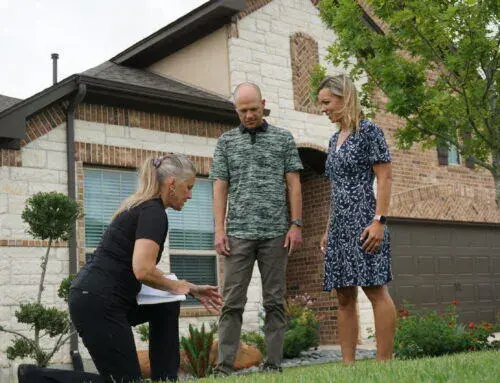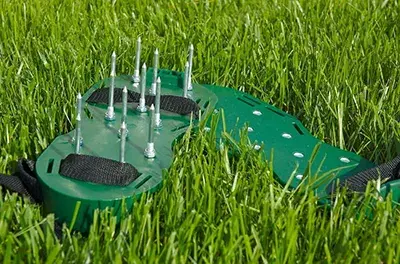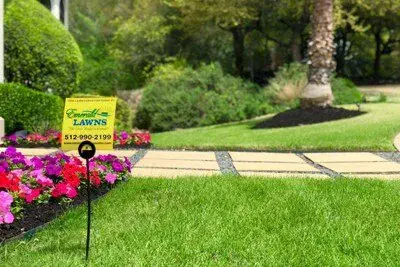Lawn Care | San Antonio
Lawn Care Aeration & Topdressing in San Antonio
![]()
Bundle & Save $$$
From Bulverde to Boerne, Helotes to New Braunfels, we create an environment where roots want to grow!
Get a Quote in 2.5 Minutes
Our pros know the optimum time for applying organic topdressing and liquid aeration.
Improve Your Soil in Greater San Antonio!
Restore soil as nature intended. Open pathways in the ground, stimulate bio-organic activity, & increase soil depth for a lawn you’ll love.
Liquid Lawn Aeration
Open up compacted soil for air & water using state-of-the-art liquid aeration.
Topdressing
Our compost adds biological organisms & organic matter for nutrient-rich soil.
Leveling
Fill in low spaces in your lawn while fortifying it from harm for the ideal look.
Liquid Aeration
Why do I need to aerate? What does aeration do?
Your lawn is like an iceberg. Your roots should be deeper & broader than your grass is tall
(which is essential for healthy turf).
Why Aerate?
Compacted soil restricts root growth. Liquid aeration, rather than core aeration, penetrates deeper & wider, creating thousands of pathways for nutrients, water & roots.
When to Aerate?
January to April & October to December are ideal. Apply prior to topdressing & spring fertilization. Fall application helps recover from summer stress.
Results You Can See.
Having a vibrant root system enables thicker, greener turf. You will see results in as little as 7-10 days! Hard soil & non-porous clay have met their match.
When to Topdress Your Lawn & Why it’s Important
Spring or Fall compost is a must-have in San Antonio’s poor soil pH.
Why Topdressing?
Our lawn topdressing service provides a dense source of carbon, nutrients & micro-organisms to infuse minerals into anemic soil.
When to Apply?
Ideally, topdressing your lawn between January-May or September-December is best. Spring topdressing provides organic matter turf needs, while a fall application helps recover from summer stress.
Custom Solutions For Your Lawn
Yard Leveling
Retain nutrients, improve your lawn’s visual appeal, and do it right with USGA-grade top-dress sand.
Professional Grade Application
We fill in the small and large shallow spaces of your lawn with a custom-built machine that can help take your lawn to the next level.
Highest Quality of Sand
We use the best, and it matters. USGA sand helps not only with leveling but it helps protect your lawn from illnesses and retains moisture.
Results Guaranteed
Making lawns beautiful and healthy is how we make friends. So we do it with a 100% Satisfaction Guarantee.
Aeration & Organic Topdressing Work Together
Homes built after 2002 have a thin soil laying atop limestone and caliche, so revitalized soil is key to a high-performing lawn!
-Compost provides a surge of organic nutrients
-Aeration loosens compact soil
DarrylSan Antonio
"Emerald Lawns is always great."
Manny service is always great, it doesn’t matter if I’m physically home watching him in person or watching him from my camera’s miles away without him knowing, the service he provides is unwavering
IreneSan Antonio
"Highly recommend."
Had an amazing experience with getting my sprinkler system checked and repaired. He made some great suggestions and improvements. He also was very knowledgeable and professional. I highly recommend him.
DannySan Antonio
"My lawn is fuller and greener than ever!"
Since using Emerald Lawns my lawn is fuller and greener than ever, even in these challenging conditions. Their technicians, like Alex, are very respectful of my property!
FAQS
Question: What does topdressing cost at Emerald Lawns?
Answer: This will require a sales representative to measure your lawn and/or the specific area you desire to apply the topdressing!
Question: How does lawn leveling differ from grading?
Answer: Grading would strip the lawn prior to application causing weeks to months of recovery time; we do not perform this service.
Question: When should I see results from my last topdressing treatment?
Answer: If you combined liquid aeration and topdressing, you will notice results faster and that last longer. When the temperatures warm up you will notice your lawn to be more vibrant. The key to remember – with topdressing, you are improving your soil’s composition which improves with an annual application.
Question: When is the best time to apply topdressing to my lawn?
Answer: There are 2 primary windows for optimum results! The 1st is January – May and the 2nd is late September – December.
Question: Do I need to aerate my lawn if I get topdressing?
Answer: We strongly encourage liquid aeration and topdressing! Liquid aeration opens up pores, creating pathways that run deep and broad for the nutrients to flow down to. Your roots will “chase” those nutrients thereby making your root system deep and dense. This in turn produces thick healthy turf!
Question: What is Emerald Lawns topdressing composed of?
Answer: As with all other applications Emerald Lawns chooses for improving soil health, we carefully select our topsoil based on the needs for Central Texas soil (which is compact, clay with high pH).
Cotton Burr – because it contains both macronutrients and micronutrients is a valuable ingredient for soil and turf-root restoration thereby aiding plant growth in the spring.
The burr is comprised of the cotton plant’s organic leftovers such as its seeds, stalks, and leaves which are a nutrient-dense and rich source of nitrogen for the compost. In addition to its nutrients, cotton burr contains high levels of useful microbes and bacteria which are outstanding for loosening clay soil. These properties make it a first-rate ingredient for amending the soil.
Pine Shavings – help the soil retain moisture, and will contribute to the flow of oxygen, water, and nutrients into the soil through the pores it creates. The pine is an excellent source of potassium, phosphorous, iron, magnesium, and additional minerals to restore the soil composition.
Pine Sawdust – is used to add carbon to the mix and to balance the nitrogen. In the fall your soil doesn’t require a “double-shot” of nitrogen for turf growth.
Rice Hulls– have three valuable attributes for amending the soil. They assist in water retention, aeration, and add organic matter to the soil, which are important in the fall and winter months.
Question: How can I prevent drought stress?
Answer: In dry Texas weather, preventing drought stress can be a challenge.
Here are steps to help prevent drought stress in your lawn!
1. Use the Cycle & Soak Watering Method. Water your lawn in three or four shorter cycles until you’ve reached 1″ of water. Shorter cycles allow the water to soak into the soil a little at a time, avoiding a runoff. Not only will you incrementally increase the depth of the water’s reach, but you’ll also promote deeper roots and healthier plants.
2. Maintain proper seasonal mowing heights. Protect your lawn from drought stress by cutting no more than 1/3 of the leaf blade when mowing.
3. Utilize Water Retention Applications (surfactants) & Optimized Irrigation Systems. Our team can ensure that your lawn water is being retained and isn’t wasted via excess evaporation or runoff.
4. Grass Cycle – Keep the grass clippings, don’t bag them. The clippings have water in them as well as nutrients that are vital for your drought-stressed lawn. Return them to the soil. Your lawn will look like it needs to be raked. Don’t worry! The grass blades will quickly fall between the standing grass blades and disappear from sight.
These articles may be helpful as well:
Question: When should I see results from my lawn aeration treatment?
Answer: If you are watering and mowing correctly, as a rule of thumb, during the growing season you should see results in 2 weeks. For weed treatments (and depending on the specific weed type) you should see “curling & wilting” in about a week. It may take up to 3 weeks for weeds to die, longer in the winter, early spring, and late fall.
Question: For leveling, how big of a hole can we fill with one application?
Answer: Our topdressing machine will apply a smooth, even layer of sand, about ½” thick. For larger divots, we will shovel sand to fill in problem spots and deploy our leveling rake & commercial brush to smooth it over. We need to make sure about ¼” of grass protrudes through the sand so as not to cause damage to the existing turf.
Question: Will one leveling application smooth all the holes and bumps from the lawn?
Answer: Unfortunately, this is usually not the case. We will do our very best to smooth these out, however, after the application has settled, there can be additional pockets that will need to be filled. When we water (or it rains), the sand often filters down into tiny air pockets in the soil, creating a need for additional applications.
Question: When is the best time to apply the leveling sand to my lawn?
Answer: Any time the grass is actively growing is an excellent time to apply the leveling application, typically mid-May through mid-October.
Question: How often should I water my lawn after a leveling application?
Answer: We recommend it at least twice a week. The more frequently you water, the quicker it will allow the grass to grow through.
Question: How soon can I apply a second leveling application if needed?
Answer: As long as we are still in the growing season and the previous application of sand has settled in, we can apply other applications as needed.
Question: Where can I get a rebate for Topdressing?
Answer: Here is a list of a few municipalities that participate. If your city is not listed, please check your local utility website.
- Austin residents can receive “$50 for at least 2 cubic yards (54 cubic feet) of compost” through the “Landscape Survival Tools Rebate”.
- Round Rock residents can save $100 for 1/4″ to 1/2″ of compost.
- San Marcos residents can access, “50% of the cost of compost service or material purchase price, up to $200”
Question: Will the leveling sand get too hot in summer and burn my grass?
Answer: No, although the surface of sand will retain heat, it will stay relatively cool below the surface, leaving no adverse effects on the lawn.
Question: What type of soil is in Texas?
Answer: In many areas across Texas, soil is thin, full of clay, and on a layer of Limestone.
As many of our customers can attest, it takes some intentionality and extra love to get a gorgeous lawn (especially one worthy of the “lawn of year” title).
During your home’s construction, the yard is stripped of any soil, compacted due to the build, and then topped with a thin layer of soil and a patch of grass. You are then left with shallow, compacted, and hard soil.
Compaction from construction and Limestone are the leading causes of soil issues in Texas, requiring soil amendment.
For more info, read this blog
Or, check out this video with our founder, Luke Hawthorne.
Question: Should I mow my lawn before a leveling application?
Answer: Yes, mow at half the lawn mower height prior to application to allow a faster recovery.
Question:How do I know if I need topdressing?
Answer: If your lawn is thin, dull in color, and/or subject to heat stress. Due to our thin and poor soil, topdressing is the single most effective solution you can do for your soil and lawn regardless of its age! We strongly recommend 1 application each year.
Question: How will an application of leveling sand affect mowing the lawn?
Answer: Mowing the lawn in the area where sand has been applied will not be necessary until the sand “settles” into the soil; typically, after two weeks.



